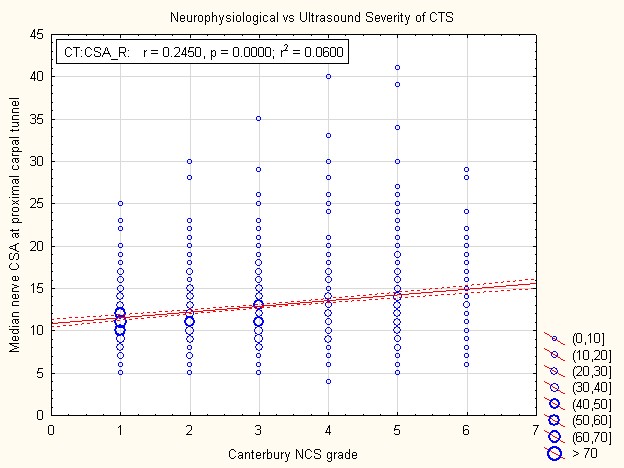Ultrasound, severity and prognosis
We do not yet know whether the imaging findings are useful for predicting the outcome of carpal tunnel surgery or injection in the same way that nerve conduction studies are, though some interesting work from the Netherlands has suggested that, in the case of ulnar nerve problems at the elbow, the imaging results do have prognostic value (Beekman 2004).
Neurophysiological vs Imaging Severity
Many of the groups who have studied the sensitivity and specificity of ultrasound for diagnosis have also tried to correlate the degree of nerve conduction abnormality with the degree of nerve swelling. A few have not been able to demonstrate any correlation (Kele 2002, Meena 2003, Sarria 2000) but most have found that larger nerves are correlated with more severe nerve conduction abnormalities (Bayrak 2007, Wiesler 2006, Padua 2008, El Miedany 2004, Visser 2008, Moran 2009, Ziswiler 2005) though the correlations have mostly not been very strong ones with r-values ranging from 0.37 to 0.8. Using the same data from the previous page but relating the CSA measurement to the Canterbury neurophysiological severity scale we obtain the following:

There is a highly significant, but weak, correlation between our nerve conduction studies and ultrasound findings. There is also starting to be a little evidence, as numbers accumulate, that some grade 6 patients may actually have small nerves, raising the possibility that there is an atrophic 'end-stage' to CTS when the nerve may get smaller again secondary to loss of nerve fibres, at least in some cases.
Prognosis
There are so far two published studies attempting to relate pre-operative ultrasound imaging to the outcome of surgery. The first, in 112 operations, found that patients with larger nerves had better post-operative outcomes (Naranjo 2009) while the other, in 88 operations found no correlation between the ultrasound results and surgical outcome (Smidt 2008)
There is one study which relates the outcome of local steroid injection to the pre-injection ultrasound imaging (Meys 2011) and in this study it was patients with lesser degrees of nerve swelling who had the better outcomes.
We are currently looking at data from Canterbury patients to see if we can relate the imaging results to the outcome of treatment and will show the results here in due course.
BACK - to the main ultrasound page
Revision date - 4th March 2012
